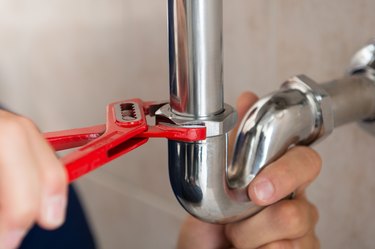
In This Article
Drain clogs are troublesome, but they often go away with with a little plunging and flushing with some household cleaning agents, such as vinegar and baking soda, and hot water.
Persistent clogs are another matter. When greasy, hair-infused black sludge in water pipes accumulates in the P-trap, the branch waste lines or the sewer, you need the cavalry. This includes a water jet, an auger and maybe even a camera, so you can see what's going on. In some cases, you'll have to do some disassembling to get things cleaned out.
Video of the Day
Video of the Day
Clean Drain Pipe Build Up
When water backs up in a kitchen or bathroom sink, and plunging doesn't have any permanent effect, solid material may have collected in the bottom of the P-trap, creating a constriction that attracts more material. A sink auger may help, but its rotating cutting heads are more effective against mid-pipe clogs. The best way to clean drain pipe build-up and drain sludge in the pipes under the sink is to disassemble them and wash them out manually:
Things You'll Need
Adjustable pliers
Bucket
Garden hose
Hose-to-faucet adapter
Drain auger
How to Remove Sludge Buildup From Drain Pipes
Step 1
Unscrew the nuts holding the P-trap to the sink tailpiece and the waste pipe in the wall. If you can't do this by hand, use adjustable pliers.
Step 2
Remove the P-trap carefully. Hold it over a bucket and invert it to empty the water. Clear drain sludge and clean drain pipe build up by grabbing it with your fingers and dropping it into the bucket.
Step 3
Take the trap outside and wash it out with the jet from a garden hose.
Step 4
Bring the hose indoors. If it won't reach the sink, use an adapter to connect it to the sink faucet. Spray water in to clear black sludge in water pipes. Spray carefully at first, in case it backs up, and then turn up the pressure to ensure that you clean drain pipe build up.
Step 5
Insert a clean drain auger into the waste opening to clear blockages that the water can't clear. Once the auger pushes its way through the clog, spray with water to push the clog into the sewer.
Step 6
Reassemble the trap after you've finished cleaning the pipes.
Tip
If you find clogs occurring frequently, you may have a clog in the roof vent. Go on the roof and clear debris from the vent opening. Spray water into the opening to clear obstructions deeper down. You can also clear the roof vent with an auger.
Sludge in Waste and Sewer Lines
If several drains in your house run slowly or frequently back up, and you're sure the vents are clear, you may have a sludge accumulation in one of the main waste lines or in the sewer. You can usually pinpoint the approximate location by noting which drains are running slowly.
Find the nearest clean-out fitting, and remove the cap with a pipe wrench. Insert an auger into the clean-out and feed the auger in the direction of the clog. Once the clean drain auger contacts the clog, crank the handle to work the head through the sludge. Prepare for a mess when you retract the auger.
Backups in sewer lines aren't always easy to pinpoint. You may need to hire a plumber to insert a camera into the pipes to see what's going on. The plumber can help determine if tree roots are responsible and plan a strategy for clearing the pipes. In some cases, a high-powered water jet may be a better choice for clearing the pipes than an auger.
Preventing Clogs
The best way to prevent drain clogs is to watch what you put in the drains. Avoid putting grease, hair, stringy vegetables, or aggregates like sand or tile grout that can collect in the bottom of the P-trap down the drain. Regularly pouring an enzyme-based drain cleaner into your drains ensures that grease and oils won't collect on the sides of the pipes.